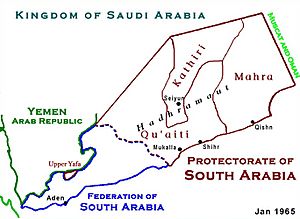Kathiri facts for kids
Quick facts for kids Kathiri State of Seiyunٱلدَّوْلَة ٱلْكَثِيْرِيَّة ٱلْحَضْرَمِيَّة فِي سَيْؤُوْن ٱلْكَثِيْرِي al-Kathīrī
|
|||||||||
|---|---|---|---|---|---|---|---|---|---|
| State of the Aden Protectorate and the Protectorate of South Arabia | |||||||||
| 1395–1967 | |||||||||
 Map of the Protectorate of South Arabia 1965 |
|||||||||
| Capital | Say'un | ||||||||
| Population | |||||||||
|
• 1952
|
60,000 | ||||||||
| • Type | Sultanate | ||||||||
| Historical era | 20th century | ||||||||
|
• Established
|
1395 | ||||||||
|
• Disestablished
|
30 November 1967 | ||||||||
|
|||||||||
| Today part of | Yemen Saudi Arabia Oman |
||||||||
| EB | |||||||||
The Kathiri State of Seiyun was a powerful kingdom, or sultanate, located in the southern part of the Arabian Peninsula. Today, this area is mostly part of Yemen and a region of Oman. The Kathiri people were known as al-Kathīrī in Arabic.
Contents
History of the Kathiri State
Founding and Early Years
The Kathiri State began in 1395. It was founded by a leader named Badr as-Sahab ibn al-Habrali Bu Tuwairik. He ruled the state until around 1430. The Kathiri people expanded their territory, even conquering the important seaport of Ash-Shihr in the 1460s.
Changes in Territory
The Kathiri tribe once controlled a very large area. This land stretched from the Aulaqi regions in the west to the Maliri tribe's land in the east. It included important coastal cities like Mukalla and Shihr.
However, over time, the Kathiri State faced many internal conflicts, known as civil wars. These wars allowed other tribes, like the Yafai, Kasadi, and Qu'aiti, to take over much of the Kathiri land. Eventually, the Kathiris were left with a smaller area inland in Hadhramaut. Their main city and capital became Say'un.
Relations with the British
In the late 1800s, the British Government became involved in the region. In 1883, Sultan Abdulla bin Salih, a Kathiri leader, visited the British Resident in Aden. He wanted to know if the British would support the Kathiris if they tried to take back the ports of Shihr and Mukalla from the Qu'aiti tribe.
The British Government warned the Kathiris in 1884 that attacking these ports would be seen as a serious problem. They even said they would send a warship to protect the Qu'aiti ruler if needed. This showed that the British wanted peace and stability in the area.
In 1895, the Kathiris did manage to capture the port of Dhufar. However, it was recaptured by others in 1897.
Settling Disputes
By 1918, a long-standing disagreement between the Qu'aiti and Kathiri tribes was finally resolved. With help from the British, an agreement was made. The Kathiris agreed to follow a treaty signed earlier between the Qu'aiti and the British. They also agreed that the British Government would help settle any future arguments between them.
End of the Sultanate
Sultan Mansur bin Ghalib passed away in 1929, and his son, Ali bin Mansur, became the new sultan.
The Kathiri State chose not to join the Federation of South Arabia, which was a group of states under British protection. Instead, it remained a separate part of the Protectorate of South Arabia. By the time the sultanate ended, its main cities, Say'un and Tarim, relied heavily on money from Kathiri properties in places like Jakarta and Singapore.
The last Kathiri sultan, Al-Husayn ibn Ali, who had ruled since 1949, was overthrown in October 1967. The following month, the Kathiri State became part of the newly independent country called South Yemen.
Kathiri Descendants Today
Many people from the Hadhramaut region, including Kathiris, moved to Southeast Asia in the 1800s and 1900s. For example, the first prime minister of East Timor, Mar'ī al-Kathīrī, is a descendant of these immigrants. His last name, 'Alkatiri', shows his family's connection to the Kathiri State. The Indonesian human rights activist Munir Said Thalib also has roots from the Kathiri people.




